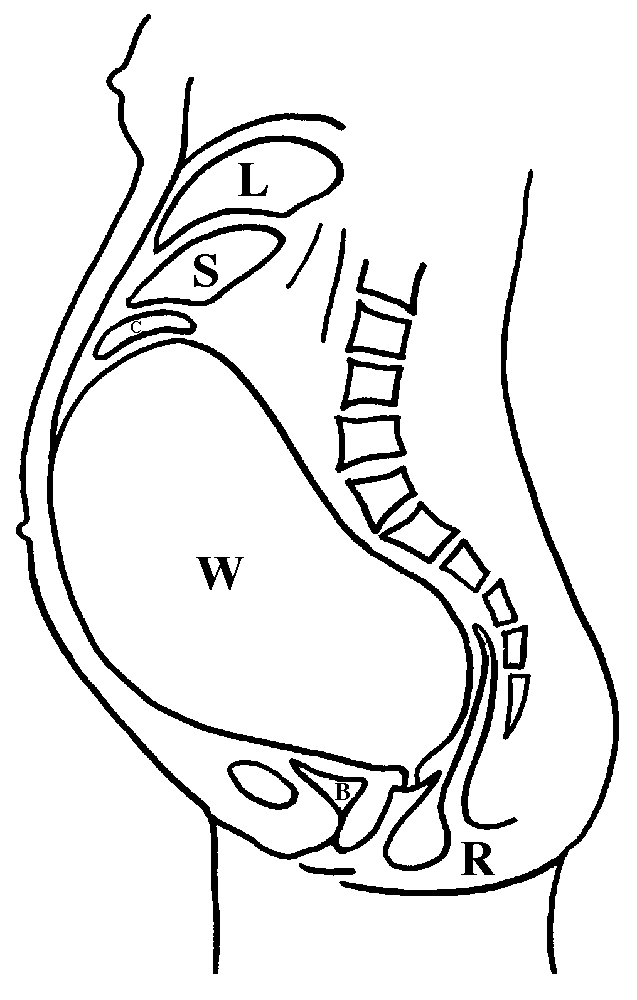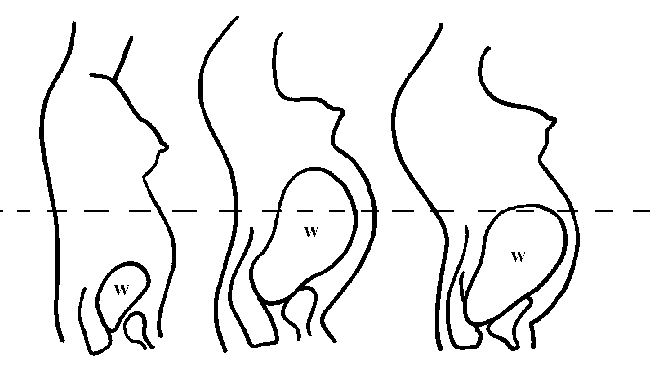Pregnancy and Posture Webpage ©
The common complications and one of the main causes

The enlarging womb of pregnancy
(showing the compression of adjacent structures)
L = liver, S = stomach, C = colon, W = womb, B = bladder, R = rectum.
Diagram reference: Modern Medical Counselor (1957)
Pregnancy symptoms and their misinterpretation about hypochondriaIn 1975 I was experiencing a very large range of symptoms which my doctor was unable to diagnose, explain, or relieve, so I decided to start reading medical books to cure them myself. The symptoms included chest pains, palpitations breathlessness, faintness, fatigue, abdominal pain, changes in blood pressure, kidney aches, haemorrhoids, and many more. Within a few years I was able to determine that I had a forward curvature in my upper spine, and that when I leaned forwards, such as leaning toward a desk repeatedly, that I was putting a lot of mechanical pressure on the internal organs of my chest and abdomen, and the pressure on my lungs was causing the breathlessness, and pressure on my stomach was causing the stomach pains etc. However, I also became aware that they were also being described by some authors as the imaginary symptoms of hypochondria. I also noticed that the same range of symptoms were seen in pregnancy, where they were regarded as the common complications. I automatically concluded that they were occurring because the pregnant womb would be putting pressure on the abdominal organs, and the chest as it enlarged and pushed upwards. I also assumed that the abdominal symptoms would be occurring in the early stages of pregnancy, and the chest symptoms of faintness and fatigue would occur in the later stages as the womb grew higher into the upper abdomen, and was able to confirm that to be true. I also found that some other authors had made similar suggestions, and that it was standard knowledge in the pregnancy text books. In that process I had discovered that the symptoms of hypochondria had a real cause, namely poor posture, and that they were not imaginary as had previously been thought. At one stage I was reading an old medical book from 1928, and it showed what doctors of that time were thinking, and why they thought that they symptoms were imaginary.
I was not surprisedNote that when I read that item I was not surprised. I had those symptoms, I had discovered that the cause was poor posture, and I had also noticed that they were similar to the common complications of pregnancy, and I knew why. I had already determined a logical explanation for the symptoms, and essentially that the symptoms of hypochonria were real and not imaginary. The old idea that the symptoms were imaginary was the result of false assumptions. See also here |
Introduction
On this webpage I briefly discuss why I have included information about the symptoms of pregnancy in relation to a theory about posture and health, and I have included a title diagram which shows how the enlarging womb crowds and compresses the internal organs, and an additional illustration which depicts the location of the womb in the three stages of pregnancy which feature characteristic
I also present quotes which indicate a relationship between posture, physique, and symptoms. These support my suggestion that women are more likely to experience symptoms if they have narrow or flat chests. This is because a large chest has ample room to accomodate the internal organs which are pushed upwards by the enlarging womb, but a flat chest is already crowded and the internal structures, particularly those between the rising womb and the chest, are more readily and more significantly compressed. Some of these symptoms continue to occur after childbirth because the internal organs, which were displaced during pregnancy, do not completely return to their original shape and position.
I have also included an interesting quote which reveals that the psychiatric ideas about pregnancy and hypochondria are based on a misunderstanding and a misinterpretation of the cause of the symptoms. The mans’ symptoms, which were the same as those caused by pregnancy, were probably related to postural compression of his chest and abdomen.
The alternating symptoms in the three stages of pregnancy
While I was attempting to find evidence for the cause of a set of symptoms which I had concluded were due to poor posture, and which included palpitations, chest pains, breathlessness, abdominal pain and fatigue, I found that these symptoms also affected some pregnant women. As there was no clear evidence that these problems were due to disease they were generally regarded as having a psychological cause and as only affecting neurotic women. However, I ultimately found that some of these symptoms were occurring in relation to the size and position of the womb. I also found that some medical authorities attributed these symptoms to the fact that the enlarging womb was compressing internal structures.
There was other evidence which made it obvious to me that the cause was primarily mechanical pressure.
In this regard, in the early stages of pregnancy while the womb is enlarging in the pelvic area it compresses the bladder, resulting in frequency of urination.
Soon after this the womb lifts out of the pelvis and enlarges toward the chest. At this stage the urinary problem subsides, and the woman starts to have problems with other symptoms which include faintness which can occur when the woman lays on her back and the womb compresses the abdominal veins. This can be relieved by laying on the side. There may also be heartburn and breathlessness which occur because the enlarging womb compresses upwards against the stomach, diaphragm and lungs. Other symptoms occur because the womb compresses the heart, kidneys, and bowels, and include palpitations, fatigue, high blood pressure, kidney problems, and constipation. The symptoms would be more likely to occur in pregnant women with stooped spines because of the combined effect of the upward pressure caused by the enlarging womb and the downward pressure of their stoop. Therefore some symptoms can be relieved by laying with the upper body propped up by pillows because this removes the additional abdominal compression which is caused by stoop.
However in the last month of pregnancy the womb drops toward the pelvis in preparation for childbirth, so the woman suddenly experiences relief from the breathlessness and fatigue, and starts having problems with urinary frequency again, further indicating that the position of the womb is determining which symptoms are likely to occur.
More evidence of a mechanical cause is seen in the fact that women who are bearing twins, and who therefore have larger and heavier wombs, are more likely to experience such symptoms, and those who have triplets have again, a greater likelihood of having symptoms which also tend to be more severe.

The three stages of pregnancy
Notice that in the first stage the womb is pressing on the bladder to cause frequency of urination.
In th second stage the womb lifts upwards and stops pressing on the bladder, and starts pressing on the stomach and chest to cause abdominal pains, chest pains, breathlessness, and faintness.
In the third stage the womb drops in preparation for childbirth, and the pressure on the chest is relieved.
Notice also the effect on posture where there is a counterbalancing stoop in the upper spine to correspond with the forward movement of the weight of the womb. Poor posture before pregnancy makes that change more prominent.
The size and postion of the womb and the symptoms of pregnancy
About 50% of pregnant women suffer from morning sickness between the 4th and 14th week of pregnancy and typically experience nausea and vomiting immediately after getting up in the morning. “Some authorities believe that the sudden assumption of the upright position plays a part.”
Frequency of urination occurs from the 6th to the 12th week while the uterus is still within the pelvic cavity and becomes slightly bent forward. The pressure on the bladder and the stretching of it’s base stimulates the desire to void.
Backache is more common in the latter part of pregnancy in women who have poor posture and poor muscle tone, and who are carrying twins, and the extra strain on the muscles of the back can contribute to fatigue.
Fainting during pregnancy may be due to pressure on the inferior vena cava, and can be brought on by such factors as suddenly moving from a laying to a standing position.
If the woman lays on her back during the latter weeks of pregnancy her blood pressure may drop because of the pressure of the womb on her inferior vena cava which slows blood flow to the heart. “If the woman feels faint she should be turned on her side immmediately.”
The weight of the uterus can cause discomfort and sleeplessness but that can usually be relieved by placing a small pillow under the abdomen when laying on the side.
Heartburn is the most common minor symptom of pregnancy and occurs during the last 12 weeks when the enlarging womb pushes the stomach upwards, and breathing difficulties may occur because the enlarging womb is also pressing up against the diaphragm, but these symptoms are relieved spontaneously when the womb descends in the final stage of pregnancy.
Reference: Textbook For Midwives 5th edition (1964) p.59-61 and p.130-139.
Pendulous belly in pregnancy – due to poor posture
In a few cases the distance between the breast bone and pubic bone was so greatly reduced by the hunchback posture, that the pregnant womb could only find room for itself by extreme forward displacement. The pendulous belly makes the woman extremely uncomfortable, puts strain on her back, and greatly increases her fatigue. Malpresentations are common, partly because of the abnormal position of the womb.
Reference: Practical Obstetric Problems 3rd edition (1964) p. 167
Physique and problems after pregnancy
“Many women, especially women of feeble muscular development and hence most women in civilised countries who are not accustomed to active muscular pursuits, suffer, after confinement (i.e. after childbirth), from a relaxed condition of the abdominal muscles and in consequence, prolapse of the bowels, stomach, and often liver and kidneys. A great variety of nervous troubles and other disorders such as constipation, indigestion, headache, and still more serious maladies, as Bright’s disease and consumption, are the outgrowth of this prolapse of the viscera . . .. Displacements of the womb and ovaries and inflammation of these organs are likely to follow displacement of the abdominal viscera.”From: The Ladies Guide (1904)
Prolapse of the internal organs is known as “visceroptosis“.
